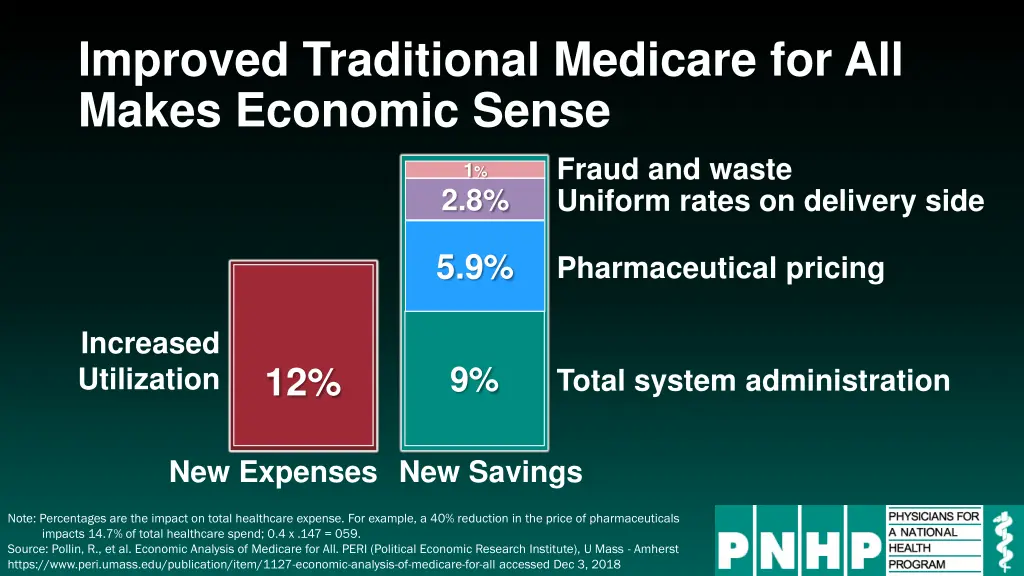
Economic Analysis of Improved Traditional Medicare for All
Explore the economic impact of implementing Improved Traditional Medicare for All, including reduced fraud and waste, uniform rates, and increased utilization. Analyze the potential savings and expenses, with one financing proposal outlined for consideration. Source: PERI, U.Mass-Amherst.
Download Presentation

Please find below an Image/Link to download the presentation.
The content on the website is provided AS IS for your information and personal use only. It may not be sold, licensed, or shared on other websites without obtaining consent from the author. If you encounter any issues during the download, it is possible that the publisher has removed the file from their server.
You are allowed to download the files provided on this website for personal or commercial use, subject to the condition that they are used lawfully. All files are the property of their respective owners.
The content on the website is provided AS IS for your information and personal use only. It may not be sold, licensed, or shared on other websites without obtaining consent from the author.
E N D
Presentation Transcript
Improved Traditional Medicare for All Makes Economic Sense Fraud and waste 1% 2.8% Uniform rates on delivery side 5.9% Pharmaceutical pricing Increased Utilization 19% 9% 12% 12% Total system administration New Expenses New Savings Note: Percentages are the impact on total healthcare expense. For example, a 40% reduction in the price of pharmaceuticals impacts 14.7% of total healthcare spend; 0.4 x .147 = 059. Source: Pollin, R., et al. Economic Analysis of Medicare for All. PERI (Political Economic Research Institute), U Mass - Amherst https://www.peri.umass.edu/publication/item/1127-economic-analysis-of-medicare-for-all accessed Dec 3, 2018
Improved Traditional Medicare for All Makes Economic Sense 19% 12% New Expenses New Savings Note: Percentages are the impact on total healthcare expense. For example, a 40% reduction in the price of pharmaceuticals impacts 14.7% of total healthcare spend; 0.4 x .147 = 059. Source: Pollin, R., et al. Economic Analysis of Medicare for All. PERI (Political Economic Research Institute), U Mass - Amherst https://www.peri.umass.edu/publication/item/1127-economic-analysis-of-medicare-for-all accessed Dec 3, 2018
Improved Traditional Medicare for All Makes Economic Sense 2017 US healthcare consumption $3.24 T Increase utilization by 12%: $3.63 T Savings of 19%: $2.93 T overall costs 19% 12% New Savings New Expenses Note: Percentages are the impact on total healthcare expense. For example, a 40% reduction in the price of pharmaceuticals impacts 14.7% of total healthcare spend; 0.4 x .147 = 059. Source: Pollin, R., et al. Economic Analysis of Medicare for All. PERI (Political Economic Research Institute), U Mass - Amherst https://www.peri.umass.edu/publication/item/1127-economic-analysis-of-medicare-for-all accessed Dec 3, 2018
Improved Traditional Medicare for All Makes Economic Sense One illustrative financing proposal for $2.93 T Continue current public healthcare funding: $1.88 T Business healthcare premiums cut by 8% overall, still leaves: $623 B 3.75% sales tax on non-necessities: $196 B 0.38% tax on net worth (exempt first $1M): $193 B Tax long-term capital gains as ordinary income: $69 B Overall, households and private businesses would pay 9.6% less than today $2.96T Note: Percentages are the impact on total healthcare expense. For example, a 40% reduction in the price of pharmaceuticals impacts 14.7% of total healthcare spend; 0.4 x .147 = 059. Source: Pollin, R., et al. Economic Analysis of Medicare for All. PERI (Political Economic Research Institute), U Mass - Amherst https://www.peri.umass.edu/publication/item/1127-economic-analysis-of-medicare-for-all accessed Dec 3, 2018
